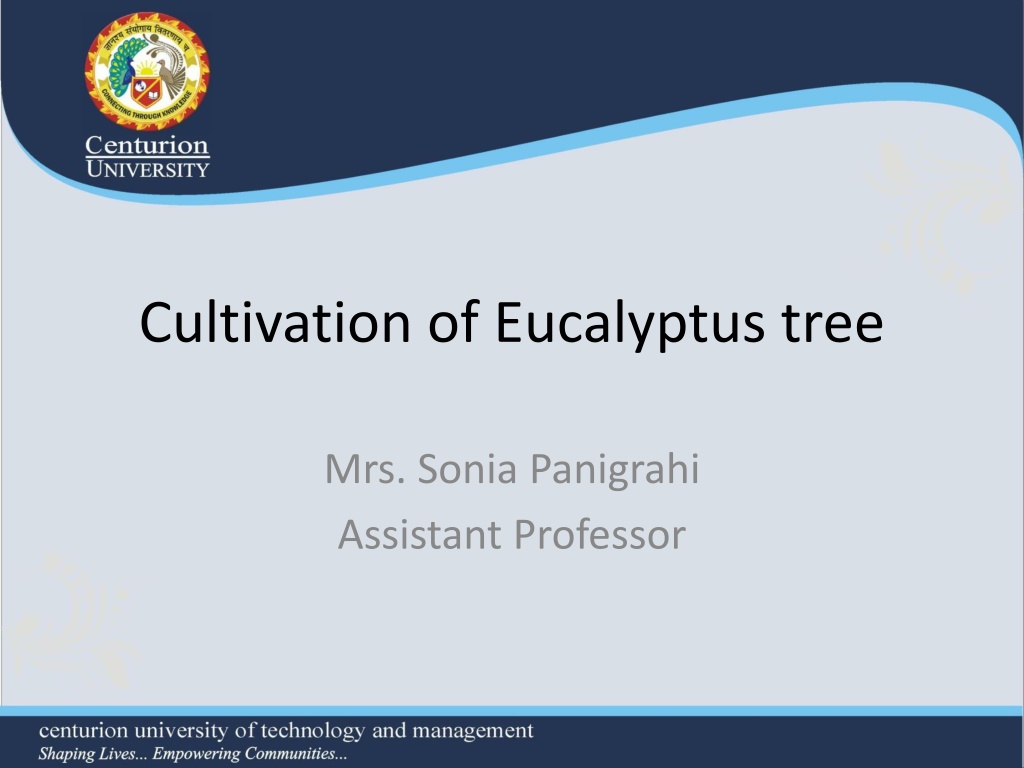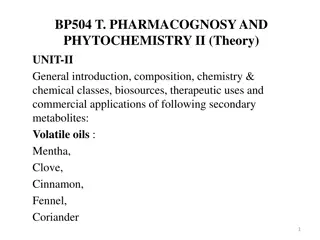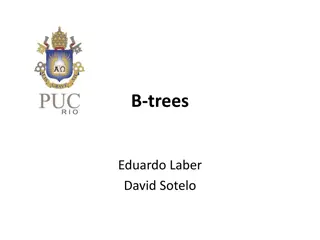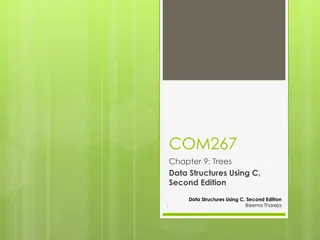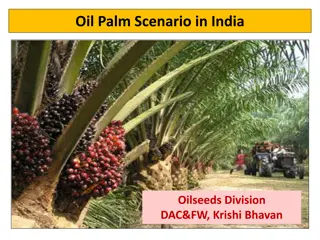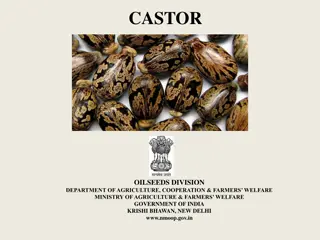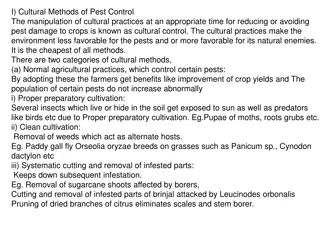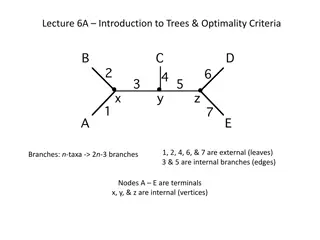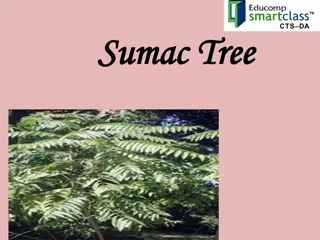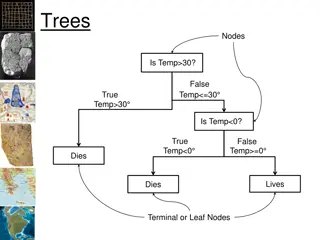Cultivation Techniques for Eucalyptus Trees: A Comprehensive Guide
Eucalyptus camaldulensis thrives in diverse soil types and rainfall conditions, making it a versatile species suitable for different environments. Seed collection, processing, and nursery techniques are essential for successful cultivation. Proper management practices, such as providing partial shade and effective plantation management, contribute to the healthy growth of Eucalyptus trees.
Download Presentation

Please find below an Image/Link to download the presentation.
The content on the website is provided AS IS for your information and personal use only. It may not be sold, licensed, or shared on other websites without obtaining consent from the author. Download presentation by click this link. If you encounter any issues during the download, it is possible that the publisher has removed the file from their server.
E N D
Presentation Transcript
Cultivation of Eucalyptus tree Mrs. Sonia Panigrahi Assistant Professor
Site factors Eucalyptus camaldulensis is a common and widespread tree species. It is a best suitable tree species for the areas which received rainfall from 250 to 600 mm at the same time it can also grow well in high rainfall areas which receives as high as 1250 mm. The success of Eucalyptus is attributed to its superiority to other trees in production of wood on infertile dry sites, its tolerance of extreme drought and high temperature. This species occurs on a variety of soil types from red or black soils to sandy alluvial soils. It can also grow well in salt affected areas.
Seed are mixed with chaff and can be difficult to distinguish from chaff. Seeds weigh approximately 700 seeds/gram (Ralph, 2003). About 100 - 500 germinant can come per gram of seed. The seeds with about 5% moisture content can be stored for more than 10 years if they are placed in hermetic containers at a temperature of 3 to 5 C.
Seed collection, processing and Nursery techniques The texture of the medium of germination must be fine. A fertile mixture of soils with sand in a proportion of 1:1 must be used. Seed should be sown under shade on a free-draining and sterilized medium and covered very sparingly with inert material (e.g. sand). Seeds must be sowed deep enough to prevent uncovering when watered, but they must not be too embedded. The germination period for this method ranges from 4 to 5 days. The seedlings are lifted from the mother bed when they are 5 to 7 cm in height and transplanted in poly bags. Alternatively, seeds can also be planted directly into bags using special devices, such as syringes, to place two to four seeds in each bag.
Partial shade is needed after transplanting till six weeks. Plants reach plantable size of 30 cm in four to five months. Seedlings require periodic watering in the first stages of development. Common mistakes in propagation are over- watering and associated disease problems, over- shading and allowing the germinants to become too large for easy transplanting leading to malformed tap roots or root curling in the pots. To prevent damping off, cupric fungicides should be applied. About 1-2 lakhs seedlings can be obtained from 1 kg of seed in nurseries.
Plantation management Weeding and burning of underbrush are recommended before planting. The ability of the species to compete with weeds is poor. In high rainfall areas, extensive weeding (2-3 times) must be applied until crowns close (2-3 years). Inadequate weed control may lead to complete failure of the planting.
A spacing of 3 m x 2 m (1667 stems/ha) is often applied for pulpwood. Wider spacing of 4 m and 2 m (1250 stems/ha) or 5 m x 2 m (1000 stems/ ha) are recommended when larger trees are required. For energy plantations, a spacing of 2x2 m is recommended.
Application of 100g of NP or NPK (3:2:1) fertilizer to each tree at planting to assist establishment of growth is common. Crown die-back during dry-season as a result of boron deficiency is prevalent in few places. A dosage of 10-20 g of borax per tree depending on soil type is applied. In India, Eucalyptus is managed through clear-felling system followed by coppice rotation to a maximum of three times. After three rotations, the below ground biomass is taken out and replanted with seedlings.For pulpwood depending on the fertility and availability of water, the rotation can fixed from 5 year to 7 years.
Agroforestry practices Agroforestry practices At a spacing of 3 x 2 m intercropping can be carried out for one year. In irrigated sites, shade loving crops can be cultivated during second year also. A wide range of crops can be grown when the spacing is 5 m x 2 m which supports intercropping up to three years. Yield In Tamil Nadu, about 25-30 t/ha at a rotation of 6-7 years was realized through seed raised plantations during early 1990 s. Introduction of clones increased the yield up to 60-70 t/ha in six years rotation. Through site-clone matching, a yield of 100-150 t/ha was achieved in five years rotation depending on the fertility level of the soil.
Important insect pest and diseases In the nursery, it is susceptible to diverse fungi causing damping-off, collar rot and leaf diseases. Attention to nursery hygiene and care not to over-water are preferable to chemical controls. Termites affect planted seedlings young trees and must be chemically controlled. Eucalyptus is severely attacked by an invasive gall insect (Leptocybe invasa) which lead to formation gall like structure in the midrip and petiole and young stem. The problem is severe in young seedlings and coppice shoots. Chemical treatments do not found to be suitable.
uses BARK All eucalypts add a layer of bark every year and the outermost layer dies. In about half of the species, the dead bark is shed exposing a new layer of fresh, living bark. The dead bark may be shed in large slabs, in ribbons or in small flakes. These species are known as "smooth barks" and include E. sheathiana, E. diversicolor, E. cosmophylla and E. cladocalyx. The remaining species retain the dead bark which dries out and accumulates. In some of these species, the fibres in the bark are loosely intertwined (in stringybarks such as E. macrorhyncha or peppermints such as E. radiata) or more tightly adherent (as in the "boxes" such as E. leptophleba). In some species (the "ironbarks" such as E. crebra and E. jensenii) the rough bark is infused with gum resin
LEAVES The leaves on a mature eucalyptus plant are commonly lanceolate, petiolate, apparently alternate and waxy or glossy green. In contrast, the leaves of seedlings are often opposite, sessile and glaucous, but many exceptions to this pattern exist. Many species such as E. melanophloia and E. setosa retain the juvenile leaf form even when the plant is reproductively mature
Flowers The most readily recognisable characteristics of eucalyptus species are the distinctive flowers and fruit (capsules or "gumnuts"). Flowers have numerous fluffy stamens which may be white, cream, yellow, pink, or red; in bud, the stamens are enclosed in a cap known as an operculum which is composed of the fused sepals or petals, or both. Thus, flowers have no petals, but instead decorate themselves with the many showy stamens.
Pulpwood Eucalyptus is the most common short fibre source for pulpwood to make pulp.The types most often used in paper making are Eucalyptus globulus (in temperate areas) and the Eucalyptus urophylla x Eucalyptus grandis hybrid (in the tropics). The fibre length of Eucalyptus is relatively short and uniform with low coarseness compared with other hardwoods commonly used as pulpwood. The fibres are slender, yet relatively thick walled. This gives uniform paper formation and high opacity that are important for all types of fine papers. The low coarseness is important for high quality coated papers.Eucalyptus is suitable for many tissue papers as the short and slender fibres gives a high number of fibres per gram and low coarseness contributes to softness.
Eucalyptus oil Eucalyptus oil is readily steam distilled from the leaves and can be used for cleaning and as an industrial solvent, as an antiseptic, for deodorising, and in very small quantities in food supplements, especially sweets, cough drops, toothpaste and decongestants. It has insect repellent properties and is an active ingredient in some commercial mosquito repellents.Eucalyptus globulus is the principal source of eucalyptus oil worldwide.
Dyes All parts of Eucalyptus may be used to make dyes that are substantive on protein fibres (such as silk and wool), simply by processing the plant part with water. Colours to be achieved range from yellow and orange through green, tan, chocolate and deep rust red.The material remaining after processing can be safely used as mulch or fertiliser.
